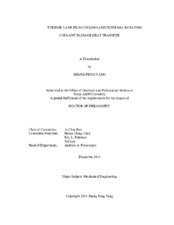| dc.description.abstract | The first part of this dissertation experimentally studies the effect of transonic flow velocity on local film cooling effectiveness distribution of turbine vane suction side. Pressure Sensitive Paint (PSP), a conduction-free method is used to determine local film cooling effectiveness. Tests were performed in a five-vane annular cascade at TAMU Turbolab blow-down flow loop facility. The exit Mach numbers are controlled to be 0.7, 0.9, and 1.1, from subsonic to transonic flow conditions. Three foreign gases N2, CO2 and Argon/ SF6 mixture are selected to study the effects of three coolant-to-mainstream density ratios, 1.0, 1.5, and 2.0 on film cooling. Four averaged coolant blowing ratios in the range, 0.7, 1.0, 1.3 and 1.6 are investigated. The test vane features 3 rows of radial-angle cylindrical holes around the leading edge, and 2 rows of compound-angle shaped holes on the suction side. Results suggest that the PSP is a marvelous technique capable of producing clear and detailed film cooling effectiveness contours at transonic condition. The effects of coolant to mainstream blowing ratio, density ratio, and exit Mach number on the vane suction-surface film cooling distribution can be obtained, and the consequence results can be presented and explained in this research.
The second part of this dissertation experimentally investigates the effect of rotation on heat transfer in typical turbine blade serpentine coolant passage with ribbed walls at low Mach numbers. To achieve the low Mach number (around 0.01) condition, pressurized Freon R-134a vapor is utilized as the working fluid. The flow in the first passage is radial outward, after the 180° tip turn the flow is radial inward to the second passage, and after the 180° hub turn the flow is radial outward to the third passage. The effects of rotation on the heat transfer coefficients were investigated at rotation numbers up to 0.6 and Reynolds numbers from 30,000 to 70,000. Heat transfer coefficients were measured using the thermocouples-copper-plate-heater regional average method. Heat transfer results are obtained over a wide range of Reynolds numbers and rotation numbers. An increase in heat transfer rates due to rotation is observed in radially outward passes; a reduction in heat transfer rate is observed in the radially inward pass. Regional heat transfer coefficients are correlated with Reynolds numbers for non-rotation and with rotation numbers for rotating condition, respectively. The results can be useful for understanding real rotor blade coolant passage heat transfer under low Mach number, medium-high Reynolds number and high rotation number conditions. | en |


